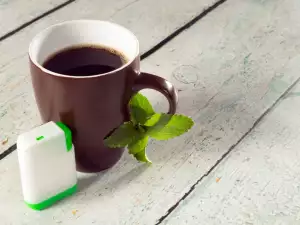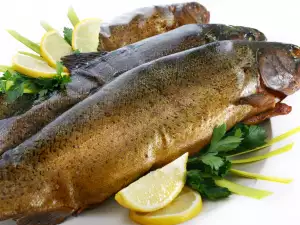When we buy ice cream to feel cool on hot summer days, we rarely look at its label. Whoever has made it, however, saw E412 written on it. This supplement may also be labeled as guar gum. It slows the crystallization of ice and is therefore used in making ice cream as well as in dessert creams.
Those who like to read product labels have seen it on meat, dairy, cheese, jellies, jams and toppings. It is used as a stabilizer in these foods. It is also present in bakery products. There is a flour enhancer in them. It is added to sauces, ketchup and spices to give them a hard consistency.
Additive E412 is also added to some salads, juices, dry soups and canned fish and is usually combined with other ingredients that make the structure of the products suitable for the stores. Usually the different ingredients influence each other, each enhancing the action of the other. What is guar gum and how is it obtained? Is it harmful to the body?
What raw material is guar gum made from?
Additive E412 is obtained after the extraction of seeds from a type of leguminous plant. The raw material for obtaining guar gum is an angiosperm with the Latin name Cyamopsis tetragonobola from the genus Cyamopsis of the Fabaceae family. Its popular name is guar or guar bean. It is a durable and drought-resistant leguminous crop.
The plant grows upright, reaching a maximum height of 2-3 meters. It has one main single stem with fine branching along it. Guar roots can access soil moisture at shallow depths and its root system develops near nitrogen-binding bacteria in the soil.

Its stem and leaves are hairy, depending on the variety. The leaves are fine and have an elongated oval shape, 5 to 10 centimeters long. The plant blooms with white to bluish flowers. Its pods are flat and thin and contain 5 to 12 small oval seeds up to 5 millimeters long. Ripe seeds are white or gray in color, but if there is excess moisture they may turn black and no longer sprout.
The most valuable thing in the plant are the seeds. They have a remarkable characteristic. Their core consists of a protein-rich germ. They also contain large amounts of galactomannan. It is a polysaccharide containing polymers of mannose and galactose in a ratio of 2:1. This gives it a high binding activity that makes a viscous effect in liquids.
Guar is drought tolerant and sun loving, susceptible to frost. It can survive low rainfall but requires soil moisture before planting and during seed growth. Frequent periods of drought can delay ripening. Excessive moisture during the early flowering phase and after ripening leads to lower seed quality. Guar grows best in moderately alkaline, fertile and sandy, well-drained soils.
Proliferation of Guar
Guar is grown mainly in the northwest of India and Pakistan. It can sometimes be found in some areas of Texas in the USA, Australia and Africa. The most important region for guar is in Rajasthan, India. This country is also the main producer of grains, providing 80 percent of the world production. Indonesia, Malaysia and the Philippines also grow guar in the drier tropics and subtropics. In the US, it was developed as an industrial crop for the production of chewing gum during World War II.
Use of guar gum
Traditionally, the main use of guar has been as a cover crop and as a shade plant for ginger and turmeric. Its sweet and tender pods are eaten as a vegetable in northwestern and southern India. They are eaten for breakfast after drying and being fried. Ripe seeds are a good option when food is scarce. Guar is also grown as a dry and fresh forage crop.
In the rest of the world, outside of traditional guar growing areas, the seeds are most prized. They are an important source of the industrial plant resin galactomannan, which has the property of thickening 5 to 8 times more strongly than starch. It is therefore used as a thickener and stabilizer in salads, ice cream, yogurt, canned vegetables and bread products and cheese making, as well as tobacco products.

Guar gum is used to strengthen the structure of food products.
It is also a filtering agent in the mining industry. They put it as an additive in drilling fluids and during drilling operations.
The by-product of guar gum extraction is an important source of animal feed, with a protein content of about 40 percent.
Guar seed extracts are being tested as a drug for non-insulin-dependent diabetes and hypercholesterolemia. The leaves of the plant are eaten as a cure for night blindness, while the pods are a laxative.
Content of beneficial substances in guar
100 grams of green guar pods contain 82 grams of water, 4 grams of protein, 0.2 grams of fat, 10 grams of carbohydrates, 2.5 grams of fiber, 1.5 grams of ash, 0.1 gram of calcium, 6 milligrams of iron, vitamins A, C, hydrocyanic acid.
Galactomannan resin in cold water forms a gel of extremely high viscosity at low concentrations. Viscosity generally depends on temperature and concentration. The maximum viscosity is achieved at 25-40°C.
Commercial guar gum is 78-82 percent galactomannan with some protein and other endosperm impurities. Guar gum has a safe status, accepted in 1974 by the food agency worldwide.
Obtaining Guar Gum
Guar gum is obtained from the seeds of the guar plant by dry grinding. This is followed by a multi-stage process of grinding, sieving, in which the cotyledons are removed and splits are obtained. Edible guar gum is produced by grinding down the particles in the seed to a fine size. Most seeds are ground into guar gum in the country of production.
Guar gum was purified by autoclaving a mixture of the resin in water to give a 0.8 percent dispersion, followed by gradual addition of ethanol to a concentration of 40 percent and repeated centrifugation to precipitate the pure galactomannan.
Purified rubber can be chemically modified to tailor its gelling and water-holding characteristics to various additive applications.
Impact of guar gum on the human body

Guar gum has excellent biological activity and acts as an anticoagulant. The supplement has antitumor and antiviral activity and helps remove heavy metals that have entered the body. Due to its excellent properties, E412 is added not only to basic food products, but also to more specific requirements such as those in dietary and baby food. The presence of guar makes any food product beneficial.
There is no precisely defined recommended dose of this substance when adding it to food products. E412 does not belong to allergens and does not irritate the stomach and other mucous membranes in the body. It is recommended as an additive and stabilizer in the food industry.
It is believed that the regular use of guar gum in food reduces appetite, lowers cholesterol and improves calcium absorption, helps to release toxins from the intestines. It can also have a laxative effect. It is suitable for dietary menus, because it creates a feeling of satiety.
See more about xanthan gum and what the most harmful preservatives are.















Comments